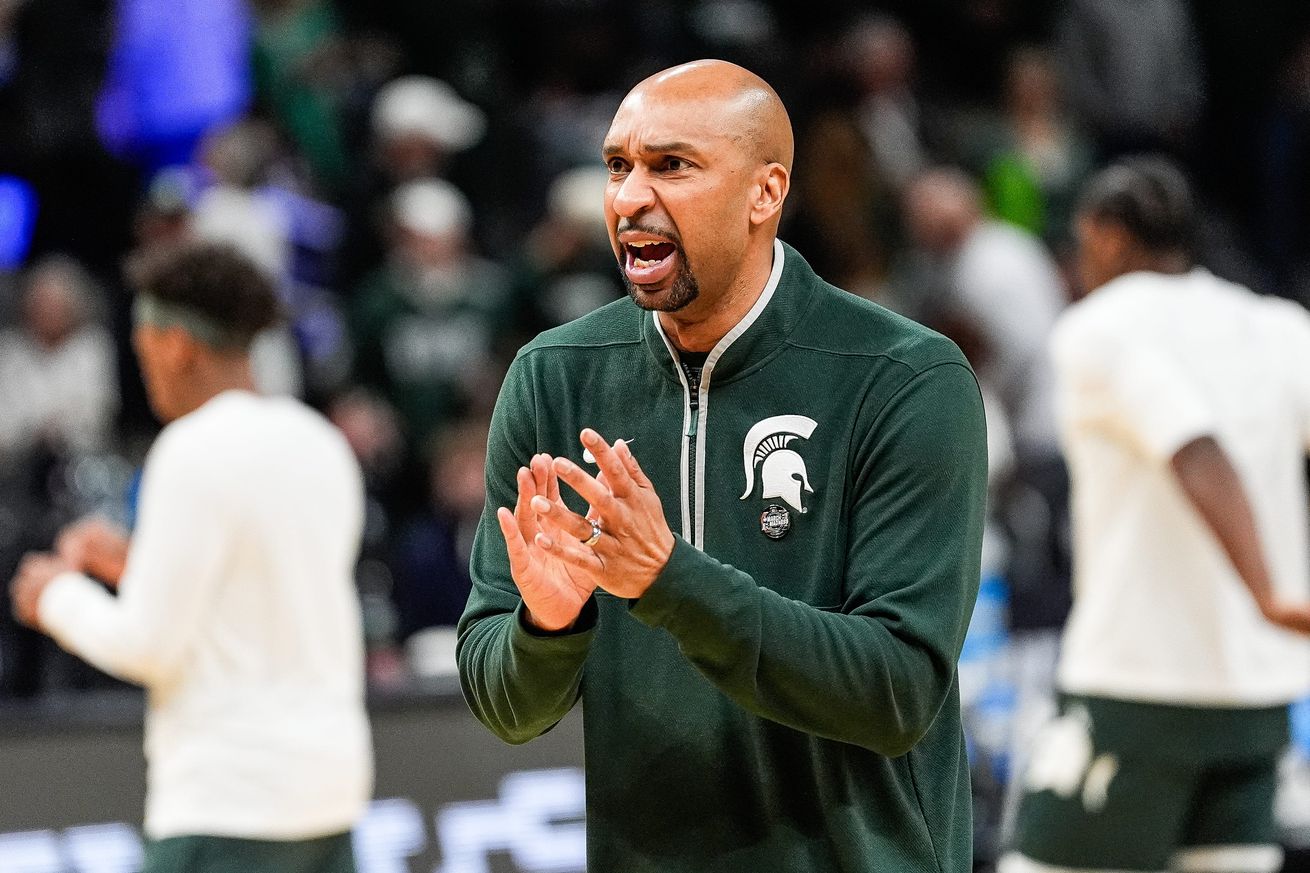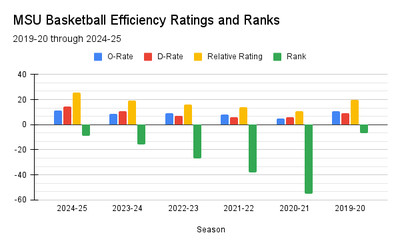
MSU’s newest assistant had a big impact in his first year on Tom Izzo’s staff
Michigan State basketball assistant coach Saddi Washington recently tweeted (or maybe X’d – whatever, I don’t know) about his first year on Tom Izzo’s staff.
A yr ago I was discouraged & frustrated about where my career was going. I even questioned if God saw me. Enter Coach Izzo & @MSU_Basketball . I can’t say enough about the PEOPLE I’m blessed to work alongside everyday. Standing firm in FAITH matters! #WatchHimWork #Yr2Loading pic.twitter.com/4ybOBNdfCE
— Saddi Washington (@saddiwashington) June 6, 2025
His sentiments obviously speak to how thankful he is to be in East Lansing but, reading between the lines, it could also be a reference to his previous employer. This, of course, just happens to be the University of Michigan. Washington was hired by John Beilen, remained on staff when Juwan Howard took over in Ann Arbor, but was not retained by Dusty May when he became Michigan’s head coach prior to last season.
Back in April (and in a mailbag response to a question from TOC reader Izzo4POTUS), we speculated that Washington could be a possibility to take over for Izzo. We thought it might be interesting to take a look at Coach Washington’s background and his impact in one year at MSU.
Although Austin Thornton was promoted from video coordinator to assistant coach prior to the 2024-25 season, Washington was the only new member of Izzo’s coaching staff this past year. He replaced Mark Montgomery, who took the head coaching job at Detroit Mercy.
As most MSU basketball fans know, Washington is a Lansing native. He is the son of former MSU great Stan Washington, who averaged 18 points and 10.5 rebounds per game over three seasons for the Spartans in the mid-1960’s. Stan’s junior season in 1965 was his best statistically as a Spartan when he averaged 21.3 points and 10.8 rebounds per game. Unfortunately, there weren’t many bright spots beyond that as the Spartans went just 5-18 overall and 1-13 in the Big Ten – good for last place. Stan’s senior season was a huge turnaround, however. The Spartans improved to 15-7 and 10-4 in the Big Ten – good for second place. Stan led the way again with 18 points and 10.6 boards per game.
Saddi starred in basketball and track at Lansing Sexton High School and received All-State recognition in both sports in 1993. Saddi continued his basketball career at Western Michigan where he made the MAC All-Freshman team in 1994 and All-MAC first team in 1998. Washington attended four different NBA training camps between 1998 and 2004 but never had the opportunity to play in an NBA game. Instead, he made a career overseas and in the Continental Basketball Association (CBA).
Washington turned to coaching in 2005 as a volunteer assistant at Romulus High School for current Alabama head coach Nate Oats. After just one year at Romulus, Oakland University’s Greg Kampe hired Washington as an assistant coach in 2006 and later promoted him to Associate Head Coach in 2013.
John Beilein brought Washington to Ann Arbor following the 2016 season. In Saddi’s eight years at Michigan, the Wolverines won a Big Ten regular season title, two conference tournament titles, and made the 2018 NCAA championship game.
At Michigan, Washington was primarily responsible for coaching the bigs and wings and coordinating defensive strategy. He helped develop Ignas Brazdeikis, Moussa Diabate’, Caleb Houstan, Isaiah Livers, Jordan Poole, Franz and Moritz Wagner and D.J. Wilson – players who were all selected in the NBA draft.
While in Ann Arbor, Washington also earned a strong recruiting reputation. He was named college basketball’s top recruiter by 247Sports for the 2021 class when he helped bring Diabate’, Houstan, Kobe Bufkin, and Frankie Collins to UM.
Fortunately for the Spartans, May’s decision not to keep Washington in Ann Arbor has paid immediate dividends for Izzo and the Spartans. As everyone here knows, the 2025 Spartans went 30-7, won the outright Big Ten regular season championship, and advanced to the Elite 8 in the NCAA tournament.
Michigan State last won a share of the conference title in 2020, prior to the Big Ten and NCAA tournaments being canceled due to Covid. In the four years between those conference championship years, and prior to Washington joining the staff, MSU went just 79-54. They lost 13 games in three of those years and 15 games in the season before Washington’s arrival. MSU advanced to the Sweet 16 in 2023 but otherwise didn’t advance past the second round during those four years.
The Spartans’ combined offensive and defensive efficiency rating also returned to elite status this past year with Washington’s addition. As seen in the table and corresponding chart below, MSU’s efficiency ratings had been steadily improving since 2021 but, last season, jumped into the top 10 for the first time since 2020. Note that the EvanMiya ratings are used here – they seem to be the most readily available and complete ratings for the past five years. See the footnote at the end for an explanation of these ratings.


Please note that in the chart above, Rank is shown as negative in an attempt to draw a contrast to Rating.
Additionally, the Spartan bigs, which may have become an offensive liability over the last few years, saw a nice increase in production this year.

Although Szymon Zapala saw his statistical production decrease from his 2023-24 season, which he spent at mid-major Longwood University, he started most games for the Spartans this year and proved to be a reliable part of MSU’s front court rotation.
Of course, it’s impossible to say how much of the Spartans’ improvement is due to Washington – there are certainly numerous other factors involved – but it seems safe to say that he had a very positive impact. It will be interesting to gauge this impact going forward and if it ultimately leads to an even bigger role for Washington with MSU basketball.
As defined by Evan Miyakawa :
O-Rate: Team Offensive Efficiency Rating reflects a team’s expected offensive efficiency. This number can be interpreted as the points per 100 possessions better than average expected when playing against an average D1 team. However, each team’s O-Rate is actually based on how its offense would perform against other similarly ranked teams. A higher rating is better.
D-Rate: Team Defensive Efficiency Rating reflects a team’s expected defensive efficiency. This number can be interpreted as the defensive points per 100 possessions better than average expected when playing against an average D1 team. However, each team’s D-Rate is actually based on how its defense would perform against other similarly ranked teams. A higher rating is better.
Relative Rating: Team Net Relative Rating is the sum of a team’s O-Rate and D-Rate. This rating is the ultimate measure of a team’s expected overall strength, relative to other teams ranked similarly. The Relative Rating value can be interpreted as the number of points the team is expected to outscore an average D1 team by in an 100 possession game. However, each team’s Relative Rating is actually based on how it would be expected to perform against other similarly ranked teams.
Relative Rating Interpretation Example: If Kansas has a Relative Ranking of 3rd, this means that they are expected to lose head-to-head to the teams ranked 1st and 2nd, but win head-to-head against the teams ranked 4th, 5th, and so on. Suppose Michigan State is 4th, and Kansas has a Relative Rating of 25.0 and MSU has a Relative Rating of 23.0. This means that Kansas is expected to beat Michigan State by 2 points per 100 possessions. If they played a typical 70 possession game, the game prediction would have Kansas favored by 1.4 points.
